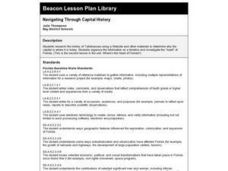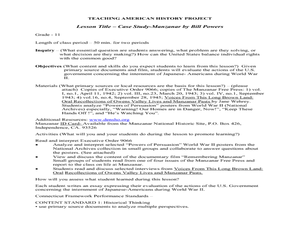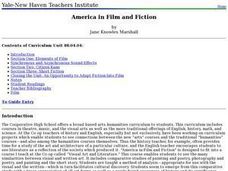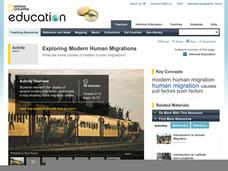Curated OER
Navigating Through Capital History
Fourth graders research the history of Tallahassee using a Website and other materials to determine why the capital is where it is today. They organize the information on a timeline and investigate the "heart" of Florida.
Curated OER
Noncombatancy and the Seventh day Adventist Church
Upper graders investigate how the Seventh Day Adventists are objectors to the practice of war. The lesson covers the Civil War and examines the church's position about the practice of war. The research extends to modern wars and learners...
Curated OER
Creating a Newscast on the Cold War
Learners research the events of a specific year of the Cold War. In this Cold War lesson, students investigate the causes of the Cold War and highlight the events of a particular year. Learners create a...
Roy Rosenzweig Center for History and New Media
The Revolutionary Times as Seen Through the Eyes of Women
The role of women before and during the American Revolution changed dramatically. To gain an understanding of these changes, middle schoolers analyze primary source documents, including letters from women that supported the patriot cause...
Curated OER
Nazis Flying Saucers – Film Sparks UFO Debate
Young scholars explore the aircraft used in World War II. In this World History lesson, students read an article that describes a "flying saucer" created by the Nazi's. Upon completion of the reading, young scholars answer questions on...
Penguin Books
An Educator's Guide to The Green Glass Sea by Ellen Klages
A lot of secrecy shrouded the creation of the atomic bomb. Readers uncover some of that secrecy using an educator's guide for the novel The Green Glass Sea. Three weeks of lesson plans feature discussion questions and reading...
Curated OER
Anne Frank: Timeline
Students brainstorm all they know about World War II and Anne Frank. They create a timeline of the events that occured. They research the events on the timeline in their own family history.
Curated OER
US Government: Foreign Policy
Pupils explore the basic precepts of American foreign policy. In this diplomacy lesson, students read textbook chapters regarding American foreign policy practices before and after World War II. Pupils also watch a filmstrip...
Curated OER
Timeline
Tenth graders examine the Holocaust from a chronological perspective. In this Holocaust lesson, 10th graders create parallel timelines on a poster about the Holocaust.
Curated OER
American History: The United Farm Workers (UFW) and Pesticides
Students are able to answer research questions through internet research. They write a bridf history of the UFW using research. Students are able to create resumes of Cesar Chavez and Dolores Huerta by researching their biography.
Curated OER
Charting Wars
Students compare and contrast details of different wars throughout history. They discuss the reasons for wars through the ages and research a war in order to complete a class chart detailing seven different wars.
Curated OER
Case Study: Manzanar
Eleventh graders investigate Japanese-American internment. In this World War II lesson, 11th graders conduct research from the Manzanar National Historic Sites and then write essays based on their findings.
Curated OER
The Homefront: America and WWII
Learners are introduced to the experiences of various groups of Americans at home during WWII, highlighting race, gender, and ethnicity. They improve their ability to analyze and interpret historical documents and images.
Curated OER
Inventions Change the World: The Enigma Machine
Third graders explore WWII by analyzing technological advances. In this invention instructional activity, 3rd graders discuss the use of the Enigma machine which decoded private German messages that communicated with U-boats. Students...
Curated OER
The Ethics of the Bomb: What Would You Do?
Learners research the use of the atomic bomb in WWII, analyze the human costs of dropping the bomb and identify the pros and cons. They develop a PowerPoint presentation on the effects of an atomic bomb dropped on their hometown.
Curated OER
Our Small World
Students explore indigenous and Native cultures, and promote appreciation for the contributions from these cultures. They explore the concept of cultural conservation and gain more understanding about the issues that tribes face today. ...
Curated OER
America in Film and Fiction
High schoolers begin the lesson by reading a book on film study. After watching the movie "Citizen Kane", they work together to identify the issues concerning the United States before World War II. As a class, they discuss how the...
Curated OER
Baby Boom and the Culture of the 1950's
Eleventh graders explain the causes, course, and consequences of the United States' role in World War II.
Curated OER
Checks and Balances: Japanese-American Incarceration
Students examine the three branches of the Federal Government and their decision to place Japanese-Americans in camps during World War II. They analyze debates made by leaders during this time period.
Curated OER
GI's, Gals & Gardens
Students, in groups, design a war participation campaign for a specific audience during WWII. They design posters and prepare an oral presentation for the class.
School Improvement in Maryland
Executive Order
After reading information about Executive Order #9066, class members assume the voice of an 18 year-old Japanese-American born in California and placed in an internment camp. Individuals then craft a letter to President Roosevelt...
National Geographic
Exploring Modern Human Migrations
Using maps, images, websites, and handouts, learners work to understand the nature of human migrations. They compare and contrast human migration from the past to the present, identify causes for migration, and trace migration routes on...
Curated OER
Rincon History Museum
Students visit the Rincon History Museum in California. They discover different periods in the state's history and discuss. They view the art and explain what can be learned from it.
Curated OER
Remembering WWII Through Memorials
Learners create memorials for lesser known WWII heroes. In this WWII lesson, students recognize the efforts of lesser know individuals and groups that contributed to the wartime cause. Learners work in groups to create a memorial for one...























